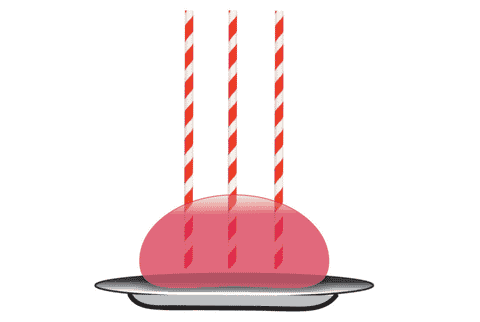Overview
Materials
Per Class or Per Group of 4-6 Students:
- Drinking straws
- Transparent tape
- Gelatin
- Soup bowl
- Large plate
- Nonstick cooking spray
Instructions
Caution: For safety, be sure to inform participants not to taste or eat any of the materials during this activity.
PREPARATION:
- Prepare a packet of gelatin according to the directions and pour it into a soup bowl that’s been sprayed with nonstick cooking spray.
- When gelatin is set, invert the bowl on a plate to produce a gelatin mound. This is the “ground” for a building. (Note: If you do this activity in small groups, each group needs a gelatin mound.)
- Build (or direct students to build) the tallest structure possible using drinking straws and tape. Instruct students to “anchor” the bottom of their structure in the gelatin. You may increase the height using any materials you care to provide, but the bottom must be kept entirely within the gelatin.
- When the structure has reached its final height, subject it to an “earthquake”: wiggle the plate back and forth quickly
- Discuss the results.
ACTIVITY:
Guiding questions
-
How tall can you build before your structure is no longer stable?
-
How tall before your structure begins to topple over?
-
Could your structure endure a natural disaster such as an earthquake?
-
What would make your tall building more stable?
-
What would help your structure stand strong even when the surface gets shaky?
Engineering & science connections
- Earthquakes happen when moving plates that make up the surface of the earth slide under each other. Civil engineers design buildings to resist the forces of earthquakes. When the ground beneath a building shakes, it makes the building sway. Because shorter buildings are stiffer than taller ones, they actually can be more vulnerable to earthquake damage than taller, more flexible buildings!
- In this experiment, the foundation is connected firmly to the structure. If the structure is not flexible enough to absorb the energy transferred from an earthquake, it will topple. One way to avoid this is to use what’s called base isolation. Engineers design base isolators with bearings, springs, or pads to separate structures from their foundations. This building method is quite common in earthquake-prone areas like Japan and California.
- The strength and stability of soil depends on its biological, chemical, and physical properties. Careful research must be done to assess the stability of the ground conditions before construction takes place. One well-known example of structural failure due to a lack of soil research is the Leaning Tower of Pisa in Italy. The soil was stable during the dry season when building began, but it becomes unstable every year during the wet season, causing the building to sink unevenly.
- Engineers sometimes decide to replace the soil with more suitable soil or build the foundation of the structure down deeper where the earth is more solid. Some buildings have a foundation as deep underground as it is tall above the ground! In this activity, the foundation would be attached to the sturdy plate and only pass through the set gelatin. This approach is often used for large bridges crossing a river.
Needham Science Center for National Engineers Week © Copyright National Engineers Week 1995


0 Comments